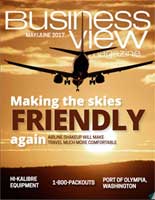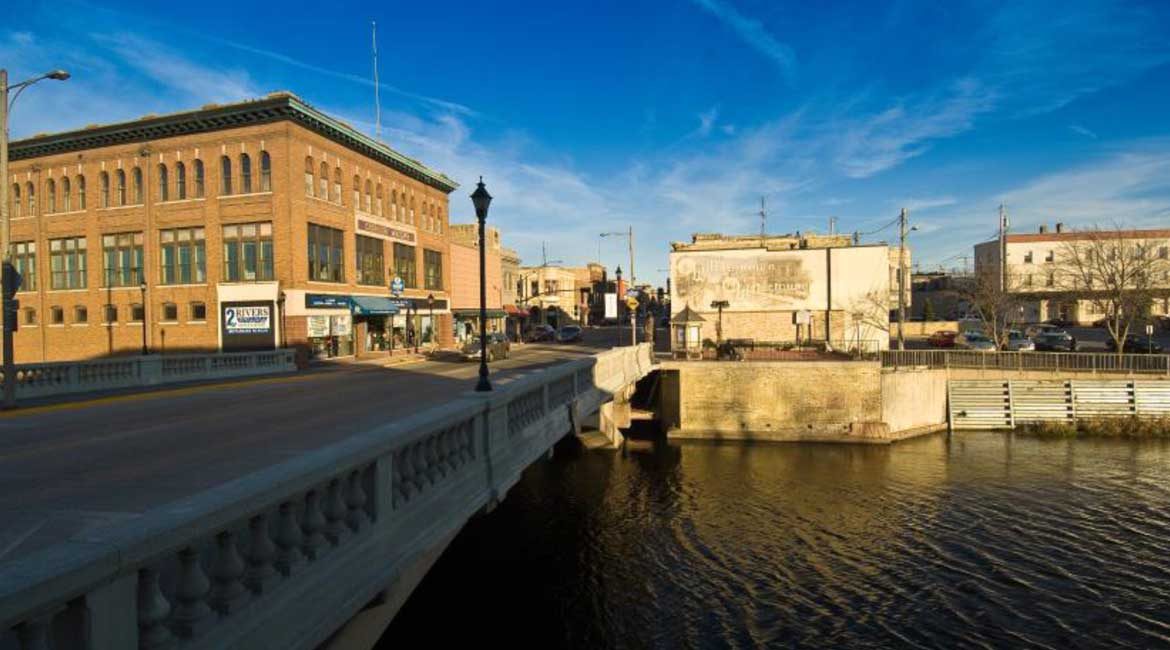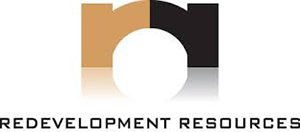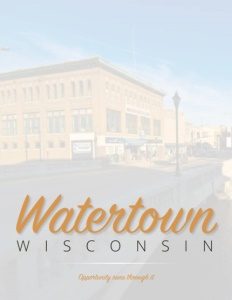Business View Magazine interviews Mayor John David of Watertown, Wisconsin, as part of our focus on infrastructure rehabilitation in American cities.
The Rock River, a tributary of the mighty Mississippi and known by the Sauk and Fox Indians as “Sinnissippi,” meaning “rocky waters,” runs through the city of Watertown, Wisconsin. In the east side of town, the waters flow, somewhat uncharacteristically, from south to north. The river then makes a steep horseshoe turn at the northern apex of the city and continues on its way – now north to south – toward the Illinois border and beyond, picking up several smaller rivers along its way, until it joins the Mississippi at Rock Island.
The area was initially settled to utilize the power of the Rock River, first for sawmills and later for hydroelectricity. In the 1850s, middle-class, German immigrants, fleeing from political turmoil in Germany, immigrated to Watertown and were welcomed by the descendants of its original Yankee population. For most of the 19th century these two groups fostered the city’s commerce, industry, arts, and education. In fact, the first kindergarten in the United States was founded in Watertown in 1856 by Margarethe Schurz, wife of statesman Carl Schurz; the building that housed this kindergarten is now located on the grounds of the city’s Octagon House Museum.
Today, Watertown has a population of approximately 24,000, many of whom work for some of the city’s light manufacturing firms. “This city, very much like the State of Wisconsin, has manufacturing as its backbone,” declares Mayor John David, before listing some of the companies that call Watertown home. “We have Eaton Corporation (a global technology leader in power management solutions that make electrical, hydraulic, and mechanical power operate more efficiently, reliably, safely, and sustainably); we have a company called Spuncast (provides centrifugal castings and stainless steel tubing products, such as hydraulic cylinders); we have Wisconsin Invest Cast (provides investment metal casting production for aluminum, steel, iron, and other metal alloys and metal prototypes molds); we have Baker-Rullman (a leader in the engineering, design, and fabrication of rotary drum dryers, modular steel bins & hoppers, structural steel, feed and seed mill systems and custom metalwork); and we have Fisher Barton (agricultural components and assemblies), that has been a very positive employer in this city. We have another company that is thinking about expanding –Ad Tech Industries (specializes in powder coating, custom assembling and electroless nickel plating services). We have a company who just recently expanded and built a new facility out in our industrial park, BASO Gas Products LLC (provides the highest quality gas valves, pilot burners, thermocouples, igniters, ignition controls, and accessories).”
“We’ve got a really nice business in town in the food industry,” David continues. “Clasen Quality Chocolate (a world-class manufacturer of confectionery coatings, fillings and chocolate.) They have been an excellent employer and have had some expansions in the city. We have another business – Johnsonville Sausage, LLC. They’ve got a processing plant in town and they make bratwurst, breakfast sausages, and various things like that. They just invested $37 million into their plant. And they are a large employer in the city with about 140 employees, right now.”
While David remains optimistic about Watertown’s manufacturing base, he admits that some jobs have been lost over the last several years. So he reports that, recently, the city government has focused on ways to bring more new residents and businesses to Watertown. It rebranded itself with the tag line “Opportunity Runs Through It,” and it has been organizing initiatives to make the most of its main, natural attraction. “We do have a large asset in the city and that is the Rock River,” he says. “It’s been used for recreational things quite a bit in the past, but we think that, especially in the downtown area, we can do more to develop and capitalize on that river and the land along the river. We want to improve the current River Walkway. We have expanded it in two areas, and we have plans to expand it into a third area. People like to walk along the river; there’s a lot of kayaking and canoeing and fishing going on. A private organization in town, Rock River Rescue, has been working on stocking quality fish in the river. So, all of a sudden, we’re seeing all kinds of people coming and fishing and enjoying the river.”
In addition, David says that the city has been “very progressive and aggressive in improving the entire city, but we’re especially looking at the downtown. We’ve got a very large downtown that is historically intact,” he states. “We’ve got some beautiful buildings, down there, and yet they do need some work. So, we are trying to initiate some programs like a low interest loan program to help businesses improve their buildings and help store owners improve their businesses. We do have a TIF (Tax Increment Financing) district and we are going to capitalize on that, also. We have had some development along the river; we have had some proposals to do some other things along the river, so we’re going to seriously look at those.”
“Another area we’re looking at is on West Main Street,” David adds. “We are looking at putting in a town square with some significant green space and along that square, a hotel. That is very big for us. It’s on our radar and we have been talking to some hotel developers. There’s a lot of interest, so far. So we want to be the initiator of some of these projects as a city, because to put it bluntly, they’re not going to happen unless we do some things to help them along. And, we are willing to do that.”
David believes that improvements in the city will help attract both the new generation of Millennial workers, as well as their Baby Boomer parents. “We’ve got a couple of apartments downtown that have attracted retired folks who have sold their homes and moved into these two new apartment buildings that are right along the river. And we have had interest from some private developers to put in other condos and/or apartments along the river for the Baby Boomer who has said, ‘I’m done owning a house; I don’t want that responsibility and yet, I want to be downtown.’ And one of the things we have done which may be more attractive to the Millennials, or some of the young family people, is we are working very hard to become a bicycle- and pedestrian-friendly community.”
Jaynellen Holloway, Watertown’s City Engineer, is tasked with making those initiatives manifest. She talks about the city’s recent bicycle projects: “About a year ago, we were seeking a grant called the Transportation Alternatives Program (TAP),” she begins. “It allows for funding and construction for bike paths, walking paths, and street improvements. We have a group in town called ‘Share the Road;’ it’s a bicycle group that came forward and said, ‘We’re looking for ways that the city can provide routes throughout the city for bicycle and/or pedestrians.’ From that we established, through our Public Works Commission, a bicycle and pedestrian task force that is working on a master plan. We’re very fortunate in that we have some county paths that go through our city; we have some state trails within reach; and we have an interstate bicycle path that goes through our city, along with some smaller trails. On our bicycle task force we have about ten members; they come from the school district, the police department, the health department, the engineering department; we have representation from Share the Road; and we have two alderpersons that sit on the committee, one of whom is also a county commissioner. In the short year that we’ve been around, we’ve been able to stripe between two and three miles of roadway.”
Staff Engineer, Andrew Beyer, elaborates: “We’ve prioritized our low and high value streets; short-term and long-term goals,” he states. “Short-term being a simple striping; long-term being shared use paths or capital outlay projects that we need to budget for. This year, we’re going to be soliciting a grant from our hospital foundation, the Greater Watertown Community Health Foundation, for a shared-use path along Carriage Hill Drive that connects West Main Street to our largest city park, Brandt-Quirk Park. It would serve the high school, Maranatha Baptist University, and several subdivisions, as well.”
“And we’re going to be looking to go back in for that TAP grant,” says Holloway. “That will become available again this coming October with the grant due in January 2018. One entity can submit multiple applications and we’re looking at submitting at least three. Two would be to expand some shared-use paths in and around our city hospital and the neighborhoods around there. Part of that project will also connect some of those subdivisions with a new convenience store/gas station, Kwik Trip. That area is currently underserved by that type of business, so now that it’s been built, everyone’s clamoring to have ways to safely get there.”
“There’s another one that we’ll be putting in,” adds Holloway. “The state came to town, maybe 15 years ago, and redid a highway through town. The old highway was turned over to the city. Just to the south end of that, we had a Wal-Mart that was built and, where there are sidewalks and bicycle lanes to the north of that street, there are no sidewalks or bicycle lanes directly to the Wal-Mart. So, one of our grants would be to put a shared-use path on that missing section, so that the college and preparatory high school students, and residents can use that to safely get to the Wal-Mart.”
Watertown is also working to preserve the cleanliness of its river. “We’re in the Rock River Watershed,” says Holloway, “which is an ‘occluded’ water stream that they’re trying to clean up. So, they’re really cracking down on any of the communities and municipalities that discharge into the Rock River – to make sure that we have our total suspended solids and our phosphorous limits in check. So, we know that we’ve got to think smarter and try to get as many low-cost and no-cost ways to reduce our total suspended solids and our phosphorous emissions. So, we’re working with all of our detention pond owners in our community to clean up and restore their detention ponds, so that we can maximize the removal limits in our existing ponds.”
Another city initiative aims to implement sustainable practices in the city’s parking lots. “Whether that’s putting some kind of permeable pavers around their perimeters; or putting in a rain garden with underground storage before water releases into the storm sewer system; we’re working with a couple of developers that are going to be reworking some of their parking lots,” Holloway reports. “And we’ve said to them, while it’s not mandatory right now, we certainly would invite them to come forth in their plans with some type of green technology for those lots and we’ve not met any resistance. They’ve all been very gracious to say that they would look into it. So, we’ve got some initiatives that are happening; we don’t have the ordinance rewritten yet, but we are looking to initiate green practices.”
“Our erosion control and post construction stormwater ordinances were revised in 2016, and this includes all redevelopments or new developments of land 3,000 square feet or more,” adds Beyer. “So, we’ve been working with developers to put through erosion control plans and stormwater management plans for these smaller sites where it’s not required by state statute. We’re a little bit more stringent in the city.”
As city projects continue to upgrade Watertown’s infrastructure and physiognomy, Mayor David stresses the city’s many virtues: “I would say that we have a fantastic quality of life, here,” he avers. “The cost of living is quite low. We’re strategically located halfway between Milwaukee and Madison. We’ve got wonderful amenities here with the river, and our park system is second to none. We have a very low crime rate. We are a full service city – we have solid waste collection, recycling collection, a full-time fire department – all paramedic-trained, and a full-time police department. There is not a service that a municipality can offer that we don’t offer.”
Holloway focuses on Watertown’s new brand – Opportunity Runs Through It – and the offer implicit within it. “That says a lot about our community,” she says, confidently. “If you were to come to Watertown and live and work in this community, there are many opportunities. And it’s a warm and accepting city,” she adds, summing up.
AT A GLANCE
WHO: Watertown, Wisconsin
WHAT: A city of 24,000
WHERE: In Dodge and Jefferson counties, midway between Milwaukee and Madison
WEBSITE: www.ci.watertown.wi.us
PREFERRED VENDORS
DIG DIGITAL?

May, 2017 Issue


